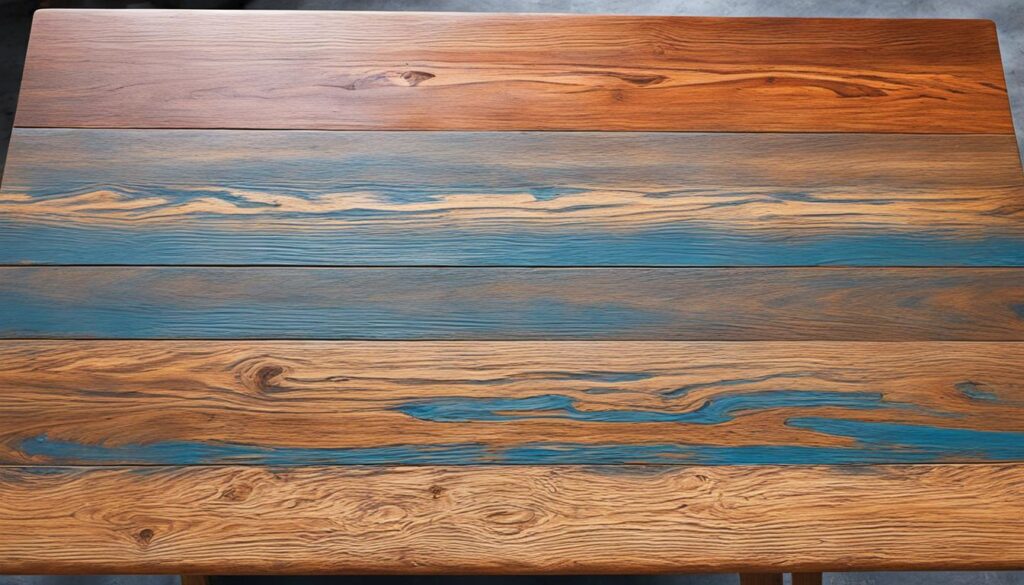Danish oil is a multifunctional wood finish primarily consisting of drying oils like tung and linseed oil. These oils are blended with varnishes or resins to enhance hardness and increase water resistance. Solvents such as mineral spirits and naphtha are included for better penetration. Additives like drying agents and waxes improve performance. Some formulations may contain volatile organic compounds (VOCs) and heavy metals, raising concerns about toxicity and indoor air quality. Proper surface preparation and routine maintenance can optimize the performance of Danish oil. Explore further for a detailed understanding of its composition and safe application practices.
Understanding Danish Oil
Understanding Danish oil necessitates an examination of its unique composition, application methods, aesthetic outcomes, and durability characteristics. This wood finishing product is renowned for its ability to penetrate deeply into the wood grain, thanks to its solvent-based formulation. The blend typically includes drying oils, such as tung oil or polymerized linseed oil, which cure and harden upon exposure to oxygen, creating a durable protective layer.
Moreover, Danish oil often incorporates varnishes/resins, such as polyurethane or natural resins, to enhance its hardness and water resistance. These components contribute considerably to the finish’s durability, making it a viable option for various wood surfaces. The solvent base, usually consisting of mineral spirits or naphtha, facilitates the deep penetration of these oils and resins, ensuring thorough coverage and protection.
Danish oil is particularly valued for its aesthetic outcomes, offering a natural look that accentuates the wood’s grain with a low-luster satin finish. Unlike high-gloss varnishes, it provides a subtle sheen that can range from matte to slight gloss, depending on the number of coats and buffing.
While it offers decent protection against moisture and light wear, periodic reapplication is recommended for maintaining its durability, especially on high-use surfaces.
Components of Danish Oil
Danish oil comprises a complex blend of drying oils, solvents, varnishes/resins, and other additives, each contributing to its unique properties and performance on wood surfaces. The formulation of Danish oil is not standardized, allowing manufacturers to create proprietary blends that vary greatly. This diverse composition guarantees that Danish oil offers a robust and versatile finish for wood.
Drying Oils: Typically, Danish oil includes tung oil or polymerized linseed oil. These natural oils cure and harden when exposed to oxygen, creating a durable, protective coating on the wood.
Solvents: Common solvents such as mineral spirits, naphtha, and aromatic petroleum distillates are used to thin the oils, enhancing their penetration into the wood. This ensures a more even and effective application.
Varnishes/Resins: To add hardness, durability, and water resistance, Danish oil often contains natural resins like copal or synthetic resins, including polyurethane varnish. These components greatly enhance the finish’s protective qualities.
Additives: Various additives, such as driers (e.g., cobalt and manganese compounds), waxes (e.g., beeswax), and additional vegetable oils (e.g., mustard seed oil), are incorporated to accelerate drying time, provide extra protection, and improve overall performance.
The precise formulation determines Danish oil’s drying time, sheen, durability, and whether it is food-safe, making each product unique.
What Is In Danish Oil
A typical formulation of Danish oil comprises several key ingredients, including drying oils, solvents, varnishes/resins, and various additives, each contributing to its unique properties and performance. The primary drying oils used are tung oil and linseed oil, both renowned for their ability to polymerize and form a durable, protective layer upon exposure to air. Tung oil, also known as Chinese wood oil, is particularly valued for its resistance to water and its capacity to impart a rich, warm hue to the wood. Linseed oil, often polymerized or boiled, is another common component that enhances the protective properties of the finish.
Solvents play a critical role in Danish oil formulations by thinning the mixture and promoting deeper penetration into the wood. Common solvents include mineral spirits, naphtha, and aromatic petroleum distillates. These solvents evaporate after application, leaving behind the solid components.
Varnishes and resins, such as natural copal resin, synthetic resins, and polyurethane varnish, are included to increase the hardness, durability, and water resistance of the finish. Additional additives, such as drying agents (e.g., cobalt or manganese compounds) and waxes (e.g., beeswax), further refine the drying time and protective qualities of the oil.
Toxicity Concerns
While Danish oil is lauded for its protective and aesthetic qualities, it is imperative to scrutinize the potential toxicity concerns associated with certain formulations. Due to the diverse nature of proprietary blends, the specific ingredients and their concentrations can vary, leading to different levels of risk.
Here are some critical points to take into account:
Toxic Chemicals: Many Danish oils contain volatile organic compounds (VOCs) such as mineral spirits, naphtha, and aromatic petroleum distillates. Exposure to these can cause respiratory irritation, headaches, nausea, and dizziness.
Heavy Metals: Some formulations include driers like cobalt bis(2-ethylhexanoate), which can lead to allergic reactions and other health issues upon prolonged exposure.
Indoor Air Contamination: Certain Danish oil products may off-gas toxic chemicals for an extended period, posing risks of chronic low-level exposure. This can potentially lead to long-term health effects, though these are not well-studied.
Combustibility Hazard: Rags used with Danish oil can undergo spontaneous combustion if not disposed of properly, primarily due to the presence of drying oils.
Given these concerns, it is advisable to select high-quality, low-VOC or natural Danish oil products and use them in well-ventilated areas while employing appropriate personal protective equipment.
Lethal Dosage (LD50) Analysis
Given the lack of a standardized formulation for Danish oil, determining its exact LD50 value is challenging; however, an analysis of its typical ingredients can provide insight into the potential toxicity of the product.
The LD50, or lethal dosage required to kill 50% of a test population, varies among Danish oil components. For example, mineral spirits, commonly used as a solvent, have an LD50 (rat, oral) of 4,900 mg/kg, indicating relatively lower acute toxicity. Similarly, naphtha shows an LD50 (rat, oral) greater than 5,000 mg/kg.
Conversely, cobalt driers, often found in Danish oil to accelerate drying, present a higher acute toxicity with an LD50 (rat, oral) of 3,129 mg/kg. This makes cobalt driers one of the more hazardous components. Other ingredients like dipropylene glycol monomethyl ether exhibit an LD50 (rat, oral) greater than 5,000 mg/kg, suggesting lower immediate toxicity.
It is essential to note that the overall toxicity of Danish oil cannot be precisely quantified due to proprietary blends and varying formulations. Moreover, while these LD50 values are based on oral ingestion in rats, inhalation exposure, a more common route during application, could yield different toxicity levels. Hence, adequate ventilation and careful handling are imperative during use.
Non-Toxic Alternatives
In response to growing concerns about the toxicity and environmental impact of traditional Danish oil formulations, several non-toxic and eco-friendly alternatives have been developed to provide safe and effective wood finishes. These non-toxic alternatives prioritize the use of plant-based oils, water-based solutions, and minimal VOCs, ensuring both user safety and environmental sustainability.
Notable non-toxic alternatives include:
Pure Tung Oil or Hemp Oil: These 100% natural drying oils offer a protective, low-luster finish without added solvents or driers, making them non-toxic and food-safe.
Citrus-Based Solvent Blends: Formulations using citrus terpenes or orange oil as solvents provide lower VOCs and toxicity. Examples are Real Milk Paint Co’s ‘Half and Half’ (tung oil + citrus solvent) and ‘Dark Half’.
Water-Based Wood Oils: Brands like Auro and Osmo offer water-based oil formulations that avoid volatile solvents entirely, providing a safer finishing solution.
Hard Wax Oils: Combining natural vegetable oils with waxes, products from brands like Osmo and Auro deliver a durable, matte finish without the use of harmful solvents.
These eco-friendly options provide effective wood finishes while minimizing health risks and environmental impact, making them suitable for interior wood projects requiring safe application and low odor.
Application and Maintenance
The application and maintenance of Danish oil wood finishes require meticulous surface preparation and careful adherence to specific steps to achieve a durable, aesthetically pleasing result. Surface preparation involves sanding the bare wood up to 240 grit or higher, making sure all previous finishes, waxes, dirt, and oils are removed. Raising the wood grain with a damp cloth before final sanding enhances oil penetration.
When applying the oil, use a cloth or brush to spread a liberal first coat, following the wood grain. Allow the oil, often containing boiled linseed oil, to penetrate for 15-30 minutes, maintaining the surface wet by reapplying as needed. After 20-30 minutes, wipe off any excess and let the first coat dry for 24-48 hours.
Subsequent additional coats require light sanding with fine grit (320-600) sandpaper between applications, repeating the same method for 2-3 more thin layers. For an ultra-smooth finish, consider ‘wet sanding‘ the final coat with oil and 600 grit paper.
Maintenance involves wiping the surface every 6-12 months with mineral spirits to remove buildup, followed by 1-2 fresh coats of Danish oil. Light buffing with 0000 steel wool or scotch brite pads is recommended before reapplication. Always make sure proper disposal of oily rags to prevent spontaneous combustion.
Welcome to WoodCraftYard.com, your one-stop destination for all things woodworking! I’m Oliver Candler, a dedicated woodworking aficionado and the creative mind behind this virtual woodworking haven. With a deep-rooted love for craftsmanship and a keen eye for detail, I am on a mission to share my passion for woodworking with fellow enthusiasts like yourself.
As a seasoned woodworker, I am committed to providing you with valuable insights, practical tips, and inspiring project ideas to help you unleash your creativity and master the art of woodworking. Whether you’re a seasoned pro or just starting out on your woodworking journey, join me as we carve, sand, and saw our way through the world of woodworking together.
Let’s embark on this woodworking adventure, where every knot, grain, and finish tells a unique story. Together, let’s craft, create, and build something truly extraordinary at WoodCraftYard.com!



